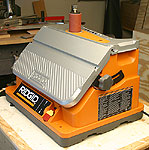 |
The Ridgid EB4424 is a solid, good-performing machine for the home woodworker.
Click image to enlarge |
Ridgid EB4424 Oscillating Edge Belt/Spindle Sander
Speed and accuracy on a budget
Text and Photos by Tom Hintz
Edge belt sanders have been around for along time, as have spindle sanders. More recently, manufacturers added an up and down oscillation motion that substantially increases the rate of material removal while prolonging the life of the sanding medium. Ridgid decided to combine an oscillating spindle sander with an edge belt drive that also oscillates. That somewhat radical thinking intrigued us so NewWoodworker.com decided to take a hard look at the Ridgid EB4424.
Initial Impressions
The Ridgid EB4424 is larger than expected, though not so big to be a problem. I have grown accustomed to the minimalist approach to sizing work tables and machines so common in the woodworking marketplace today. At 18 7/8"-wide and 16 ¼"-deep, the work table on the Ridgid EB4424 is anything but minimal.
The fit and finish of the parts is very good for any tool but especially when the every day price is only $199.
The parts and accessories included with the Ridgid EB4424 were packaged well, arrived undamaged and were assembled easily using the well-written instruction manual.
Assembly and Set Up
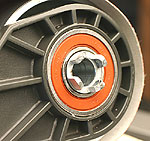 |
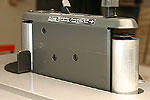 |
(Top) Both the spindle and belt drive (shown) connect to the motor through a tough cog setup.
(Bottom) The edge belt drive has a large platen that keeps the belt smooth and straight surface for those tasks.
Click images to enlarge |
The Ridgid EB4424 comes fully assembled with the exception of inserting the four rubber foot pads in their holes. Add one of the sanding elements and it's ready to go.
Setup is also very simple. I installed the sanding belt and drive and got out my best square to check the alignment, as suggested in the manual. The folding portion of the table was out of alignment by about 1/64" in the full up and 45-degree positions. I loosened the screws that secure the table indexer bracket, tapped the table into alignment and tightened the screws. After cycling the table up and down several times it was checked again and found to be correct in both the up and 45-degree positions.
The folding table also has adjustable full up stops (Allen screws, wrench included) at either end of the pivot point. I made slight adjustments to those to match the new, slightly lower position of the table after the earlier adjustments. Remember these stop-screws should the table require adjusting upward.
There is also an adjustment to insure that the belt drive is parallel with the ¾"-wide miter gauge slot. I checked that also and found it was perfectly set at the factory.
As a last check, the edge belt assembly was removed and the 2"-diameter sanding drum installed. I checked the alignment of the drum to the table and found it to be properly aligned. That concluded the setup procedure and meant the Ridgid EB4424 was ready for use.
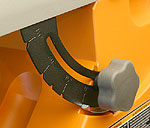 |
The forward 10" of the table can be adjusted to virtually any angle between ) and 45-degrees. Detents (accurate by the way) are provided for the more common angles.
Click image to enlarge |
The Table
The front 10" of the table folds down for angle sanding. Built in stops for 0-degrees (full up), 15, 30 and 45-degrees are provided and proved to be very accurate. The table can be set to any angle between the detents and locked in place with the hand wheel on the right side. The locking is effective, making the table very solid feeling in all positions.
I was a little concerned that the way the table folds along a seam in front of the belt drive would make sanding smaller pieces difficult if not dangerous. Throughout our testing this proved to be a non-issue with all but the smallest of parts that require extra caution regardless of how they are sanded.
Despite the Ridgid EB4424 being a benchtop machine, a full-sized ¾"-wide by 3/8"-deep miter slot runs across the entire width of the folding table. This is an important feature as it allows using most table saw miter guides. It also makes building dedicated sanding jigs much easier.
Sanding Elements
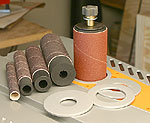 |
A good selection of sanding drums makes this a very versatile tool. On-board storage means all of the pieces are always close at hand.
Click image to enlarge. |
The Ridgid EB4424 comes with a 4" by 24" belt installed on the edge belt drive mechanism. Also included are ¾", 1", 1 ½" and 2"-diameter sanding drums, each with one sanding sleeve. A medium grit sanding element is supplied for the belt drive and each of the spindle drums with the Ridgid EB4424. Fine, medium and coarse versions of each are available at Home Depot.
A nice feature of the Ridgid EB4424 is on-board storage for the sanding elements and their related washers and knobs. Being able to store the accessories on the machine itself is not only handy, it helps reduce new clutter in our already too-cluttered shops.
Changing Sanding Modes
Changing the Ridgid EB4424 from edge belt to spindle mode or back again is fast, easy and requires no tools. With all of the components having their own "parking" receptacle on the machine, everything you need is close at hand.
A single knob atop the driven spindle frees and secures whichever element is installed. Lift the currently installed element off the drive shaft and drop in the other. Replace the appropriate knob and washer and the job is done. When changing to the spindle sanding element, a plastic table filler that closes up the recess for the edge belt sanding drive must also be dropped into place.
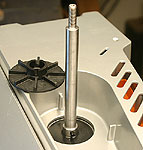 |
A removeable fan/drive plate makes cleaning dust from around the base of the driveshaft a simple but valuable task.
Click image to enlarge |
The change can be made in less than a minute and requires no other adjustments or changes to the machine.
One tip included in the manual is to clean the recess around the drive shaft when changing sanding elements, something that is quickly done with a vacuum. A smart piece of engineering was making the drive plate at the bottom of the powered shaft removable. This allows the user to lift the drive plate out to easily vacuum the area below it. This capability means the user can prevent sawdust building up in this important area that would eventually cause problems.
Changing sanding belts on the belt drive unit is identical to performing that operation on most hand-held belt sanders. Flip the tension lever to relax the belt, slip the old one off and the new one on. Flip the tension lever back to tighten the new belt and use the tracking knob so it runs centered on the rollers. The tracking knob is effective and not overly sensitive.
Dust Collection
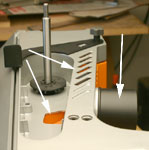 |
The dust system is surprisingly effective even when connected to a big shop vac.
Click image to enlarge |
Trying to evacuate wood dust from an abrasive element that is doing it's best to disperse it in a 360-degree pattern is one of those daunting challenges that keep engineers up far too late. The EB4424 features a 2 ½"-diameter dust port on the rear of the machine designed to work with common wet/dry shop vac hoses. The port inhales dust through a recess in the table that has a series of louvers strategically placed to maximize effectiveness. The dust system on the EB4424 is not perfect but it is more effective than I anticipated.
In the Shop
The Ridgid EB4424 is surprisingly quiet, easily making the dust collector the loudest thing in my shop when sanding on it. The motor appears to have more than enough power to drive the edge belt or spindle sanding elements but remains very quiet while doing it. Naturally, the belt drive system with its larger number of moving parts is a bit louder than when using a spindle-mounted sleeve, but not by much.
 |
Using a full-sized miter guide in the slot makes many edge-belt operations accurate, easy and safe.
Click image to enlarge |
The first few times you put wood to the Ridgid EB4424 it would be wise to be a bit cautious. You are likely to be a little surprised at how fast material is removed, something that could catch some operators off guard. Using scraps initially to get the feel of following layout lines on the Ridgid EB4424 will get you accustomed to this machine quickly.
With just a little experience, sanding to, halfway through or removing layout lines is a snap. The oscillating edge belt or spindle removes material very consistently, a trait that makes removing only the material you want a much easier task.
The belt drive has a 7"-long platen keeping the belt flat which makes working with straight edges easier and more accurate.
The edge belt drive combined with the large table surface make sanding outside curves a simple matter of following your layout line. The edge produced is both square and smooth enough to require only finish sanding or routing a decorative edge to complete.
The spindle mode excels at handling inside curves and makes those operations easy and accurate. Again, the resulting edge is clean and square. The range of spindle sizes included mean there will be few jobs the Ridgid EB4424 cannot handle.
Conclusions
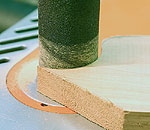 |
Following curved layout lines is easy, in part because of the selection of drum sizes with which to tailor the machine to the task.
Click image to enlarge |
The Ridgid EB4424 Oscillating Edge Belt and Spindle Sander is a solidly built, easy to use machine that brings several very useful capabilities to the average woodworking shop. For many, realizing the full potential of this sander will come only after using it for a period of time in the shop.
Circumstances delayed the writing of this review, but afforded more shop time in which to wring the Ridgid EB4424 out on a wider range of projects. Regardless of the task, I was not disappointed in it's performance.
The oscillating action makes both the edge belt and spindle sanding modes more effective, which translates into less force being required against the sanding element. While this means faster sanding, I found it also allowed me to concentrate more on hitting the layout lines and to be more accurate. Being able to follow a layout line so closely and get a square edge at the same time means projects turn out better and faster. The chance of a mistake requiring a new part to be made or altering a design to hide an error goes down, making your shop a little more efficient.
Between the large table and the range of spindle drum sizes included, the Ridgid EB4424 can handle a huge range of sanding tasks with ease. The size of the table makes it easy to control even large work pieces, which translates into a level of accuracy not possible on so many other sanding centers that come with undersized work surfaces.
Downside
The only negative I found with the Ridgid EB4424, and it is a small one, was that the paint on the work table scratches easily. The good news is those scratches do not affect function or accuracy. I applied a coat of Johnson's Paste wax to the table surface which helped prevent the scratching and kept the wood sliding smoothly in spite of them.
It is important to note that all sanding mediums lose some grit particles during use and it appears these particles are causing the scratching when they become lodged under the workpiece. That suggests two things: The amount of scratching can be substantially reduced by blowing off the work table frequently and this is a problem that will be encountered on any sanding machine, not just the Ridgid EB4424.
The Ridgid EB4424 is a good choice to handle edge belt and spindle sanding chores in the home woodworking shop. It is well built, easy to use, accurate and carries a reasonable price tag. You can also see and touch one at your local Home Depot store before buying it. If you need edge-belt and spindle sanding in your shop, the Ridgid EB4424 deserves a hard look.
Visit Home Depot on-line.
Do you have a comment about this page? - Email Me!
Back to the Tool Reviews List
|
![]()









